I know I had a difficult time coping with this topic, both emotionallyand spiritually. I can't say that I have perfected the right "attitude"about what the future holds. To be honest, I think I always held backfrom accepting the facts. I had hope. But this new evidence forces meto open my eyes and soul to setting my life in order. I hope it will dothe same for you.
Although "doomsday" is frequently linked with the Mayan calendar, thisis just coincidental. December 12, 2012 is a significant day inastronomy because of a number of important events that will impact ourSun. It would be a "doomsday" even if we never knew about the Mayancalendar. Yet, the more we understand this ancient civilization andappreciate their knowledge of astronomy, we must assume they knew thisdate to be auspicious. So let's just talk about astronomy here. There'sa lot of information. I'll try to make it easy to understand.
Glazed donuts on the Moon
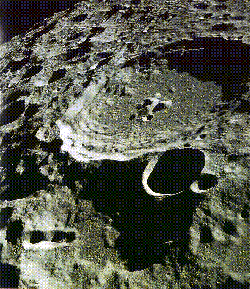 Let'sbegin back in the 1960s with the Apollo 11 manned landing on the moon.On one of their EVA's (extra-vehicular aqtivities), the astronautsphotographed and took samples from some small craters, about 20cm to1.5 meters across. When they examined the floors of these craters theynoticed what looked like glazed donuts. These were actually chunks ofmoon dirt that were coated by glass.
Let'sbegin back in the 1960s with the Apollo 11 manned landing on the moon.On one of their EVA's (extra-vehicular aqtivities), the astronautsphotographed and took samples from some small craters, about 20cm to1.5 meters across. When they examined the floors of these craters theynoticed what looked like glazed donuts. These were actually chunks ofmoon dirt that were coated by glass.
The glazed areas are clearly concentrated toward the top surfaces ofprotuberances, although they exist also on some sides. Points and edgesappear to be strongly favored for the glazing process. In some cases,droplets appear to have run down an inclined surface for a fewmillimeters and congealed there. [1]
Hardly anyone in the general public was made aware of this discoveryand, even if they were, thay could hardly have realized thesignificance.
But in 1969, an article in Science by T.Gold [1] proposed a theory of how they were made. Glass, as we know, ismade from melting sand. It occurs natually near sources of hightemperature, such as volcanos and meteor impacts. The atom bomb testsin New Mexico's White Sands area produced a small "lake" of glass atground zero. So it was never a question about the lunar glass alsohaving been created by something very hot.
The fact that the glaze was confined to small patches, 0.5 to10mm, suggested to scientists that the surface had been zapped ratherthan slow-cooked. And the likely source of this zap was our Sun. Goldestimated that the solar luminosity would have had to increase by 100times what it is normally, for a duration of from 10 to 100 seconds.
Also, because of the lack of debris or dirt covering thisglass, it must have occurred within the last 30,000 years. This madeGold propose that the Sun -- ourSun -- does this every 10,000 years or more. He suggested that futureresearch should look for a "trigger" event -- possibly a large comet orasteroid impacting the surface of the Sun. He estimated this would onlyhave to be 100 km and weigh 3 x 1021 grams.
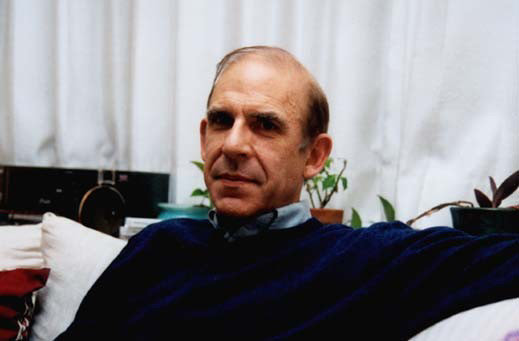 Decades passed and this theory didn't receive much attention. Then, as it often does, the theory got a fresh look by a genius, Dr. Paul LaViolette.He was not satisfied with the source of the glass being caused by asolar blast, mainly because the output would have had to be on thescale of a nova, not just a flare. He envisioned another possibility.
Decades passed and this theory didn't receive much attention. Then, as it often does, the theory got a fresh look by a genius, Dr. Paul LaViolette.He was not satisfied with the source of the glass being caused by asolar blast, mainly because the output would have had to be on thescale of a nova, not just a flare. He envisioned another possibility.
LaViolette envisioned a large solar flare or coronal mass ejection(CME) that would become magnetically entrapped in the Earth'smagnetosphere [2]. The magnetosphere would then hold on to thisfireball of radiation like a magnetic thermos bottle, allowing the Moonand Earth to be exposed for a duration of time long enough to really"flash bake" their surfaces.
Critics quickly denounced LaViolette's theory citing evidence of"cosmic dust" and rare elements in the lunar glass and concluding thatthe heat source was from a meteor impact. [3]
But LaViolette proposed that this cosmic dust was likely present on thesurface of the Moon during the time it was melted into the glass. Infact, he proposed that the entire solar system was full of this cosmicdust at the time of this solar eruption. He was vindicated when polarice cores showed unusual cosmic dust deposits at srata marking the endof the last ice age [4]. This time period, about 12,950 BCE,approximates the current age of the Moon glass. So where did all thiscosmic dust come from?
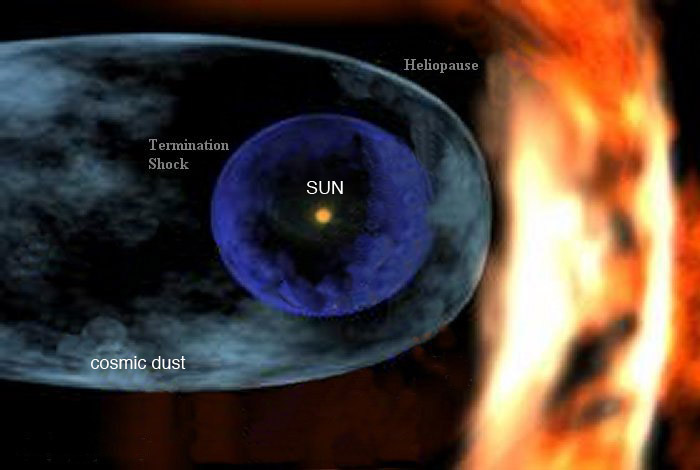
Like Earth, our entire solar system has its own atmosphere, called the heliopause.This "bubble" surrounds the Sun and planets as it travels throughgalactic space. Like our earth's magnetosphere, the movement of theheliopause creates a rounded "head" and a narrowing "tail." Actually,it's more egg shaped (see above). Until recently, astronomersbelieved that our solar system was a region relatively free from cosmicdust. The cosmic dust and frozen material of space were kept outsidethis protective bubble.
This was confirmed when the IRAS and Ulysses spacecrafts showedinfrared images of the solar system, surrounded by whispy clouds ofcosmic dust that increase in density just beyond Saturn.
So if the cosmic dust is surrounding the heliopause, what would make itsuddenly enter the heliopause and how would this coincide with hugesolar flares? LaViolette envisioned something disrupting the heliopausefrom the outside, impacting it and drawing cosmic dust inside with itand energizing the Sun. The energy of such an impact would be immense.The most logical place to look for such enormous energy was the MilkyWay Galaxy.
The smoking gun
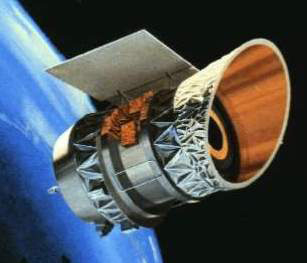 Examiningthe shape of the cosmic dust clouds, the IRAS satellite team reportedthat the cloud was tilted relative to the solar system's ecliptic --the narrow plane containing our planets. LaViolette realized that thisodd alignment tracked back to the Galactic center. This was quicklyverified by NASA's Ulysses spacecraft and New Zealand's AMOR spaceradar observatory. Whatever caused the last ice age to end, the Sun toflare up and caused the glass to form on the Moon, came from the centerof the Milky Way Galaxy. The plot was getting more interesting.
Examiningthe shape of the cosmic dust clouds, the IRAS satellite team reportedthat the cloud was tilted relative to the solar system's ecliptic --the narrow plane containing our planets. LaViolette realized that thisodd alignment tracked back to the Galactic center. This was quicklyverified by NASA's Ulysses spacecraft and New Zealand's AMOR spaceradar observatory. Whatever caused the last ice age to end, the Sun toflare up and caused the glass to form on the Moon, came from the centerof the Milky Way Galaxy. The plot was getting more interesting.
Astronomers have known about intense radiation from space sincethe 1970s. Multiple bursts of powerful gamma rays were routinelydetected and believed to originate from stars in the Milky Way.Assuming this energy originated locally, astronomers concluded thistype of gamma ray burst was insignificant and harmless. Then, inDecember 1997, they had the technology and good luck to catch a stronggamma ray burst and track it. The source was not inside the Milky WayGalaxy. It was from a distant galaxy billions of light years away.
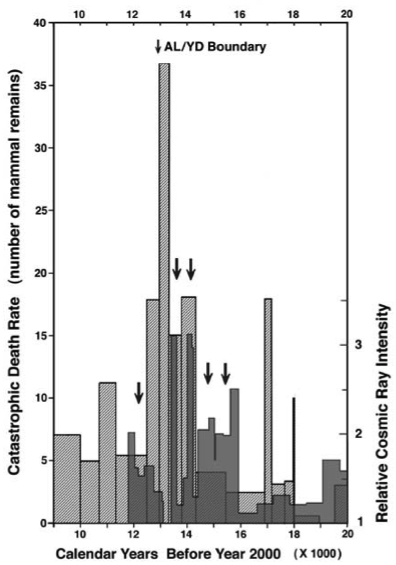 Areview of other bursts showed that their assumptions had been wrong.All of the gamma ray bursts they were observing were from othergalaxies far, far away. The amount of energy coming from objects sodistant was a real shock. No one had ever imagined such powerful burstscould be generated by galactic centers. The thought of a burst comingfrom our own Milky Way galactic center was abysmal. A burst of the sameintensity as the 1997 event, originating from inside the Milky Way,would deliver 100,000 time the lethal dose of radiation, killing everylife form that was exposed. Could that really happen to us?
Areview of other bursts showed that their assumptions had been wrong.All of the gamma ray bursts they were observing were from othergalaxies far, far away. The amount of energy coming from objects sodistant was a real shock. No one had ever imagined such powerful burstscould be generated by galactic centers. The thought of a burst comingfrom our own Milky Way galactic center was abysmal. A burst of the sameintensity as the 1997 event, originating from inside the Milky Way,would deliver 100,000 time the lethal dose of radiation, killing everylife form that was exposed. Could that really happen to us?
This question was answered on August 27th, 1998when an unusual 5 minute gamma ray pulse was located just 20,000 lightyears away in the constellation of Aquila. This may sound like a hugedistance, but to astronomers this is just "next door." The Milky WayGalaxy, for example, is just 100,000 light years from end to end.
The 1998 event was close enough and strong enough to ionize Earth'supper atmosphere, damage a couple of spacecraft and disrupt globalcommunication. Since then astronomers place gamma ray bursts from theGlaxy's core at the top of the list of things we don't want to happen.
Before Aquila, scientists just feared exploding stars -- novas andsupernovas. Now things are different. It's like living in a ghetto andfearing drive-by shootings and random bullets. Then one day you learnthat there's a nuclear bomb down the street, waiting to explode.
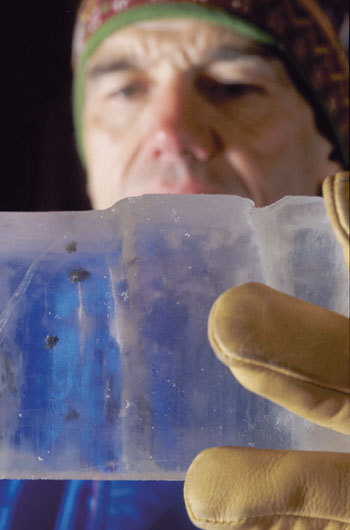 Not in my galaxy!
Not in my galaxy!
Ironically, all of these facts are incorporated in LaViolette's"superwave" theory. He concludes that there are cyclical and frequentexplosions from the Galaxy's core. These waves of radiation advanceoutward to the edges of the Galaxy, impacting everything and causingstars to erupt in their path. He believes this is what has happenedmany times to our own solar system -- the most recent superwave ofradiation being 14,950 years ago. He envisions the shock wave -- orsuperwave -- dragging cosmic dust along with it as it enters theheliopause and energizes our Sun.
Ice core samples support this view. Evidence of the effectsfrom cosmic dust show at ice core strata corresponding to the years13,880 to 13,785 BCE. This evidence, along with the Moon glass, thepresence of cosmic dust and the abrupt and atypical end of the last iceage -- all point to an intimate relationship between extreme solaractivity and gama radiation from the Milky Way Galaxy's center.
Something has changed
More troubling is the suggestion by some scientists that this powerfulradiation may not require a dramatic burst or explosion to causeeruptions in the Sun. Physicists at nearly a dozen researchinstitutions, including New York University, have discovered evidencefor very high energy gamma rays emitting from a narrow band at theequator of the Milky Way. These gamma ray levels mark the highestenergies ever detected from the Galaxy.
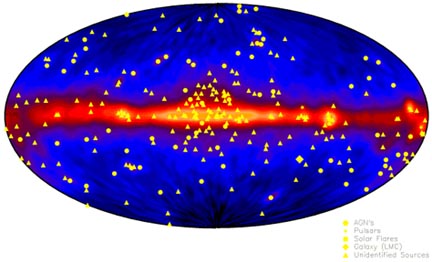
The gamma rays had a median energy of 3.5 trillion electron-volts, or3500 times the mass-energy of a proton. Previous satellite experimentshave seen gamma-ray emissions along the galactic equator reaching up toenergies of only 30 billion electron-volts.
Perhaps related to this is the puzzling fact that, even though we havewitnessed no Galactic explosions or "bursts", the measurements ofcosmic dust streaming inside the heliopause as been steadily increasing[6] to almost three times since the last solar maximum in 2001.
During the solar maximum of each 11 year cycle, the polarity of the Sunshifts -- North becomes South and visa versa. This brief period ofmagnetic instability allows some cosmic dust to enter the heliopausebecause the Sun's "shields" are reduced. But once the new polarity isestablished, the Sun usually quickly blocks the dust. This time itdidn't happen. Cosmic dust has been streaming in from the Glacticcenter and astronomers are at aloss to explain why.
It's likely that the solar system is already experiencing the invasiveenergy from the Galactic equator as we move into position and alignwith it on 2012.
Yes, there's more!
What will it be like when this happens to us? Perhaps the most dramaticevidence of what we can expect in 2012 comes from the most unlikelyplace -- ancient petroglyphs! Ancient rock carvings from around theglobe, created during the last solar "zap" 14,950 years ago, seem toillustrate a spectacular event that happened when the Earth was lasthit by extremely high radiation. This is a little difficult to explain,but I'll try.
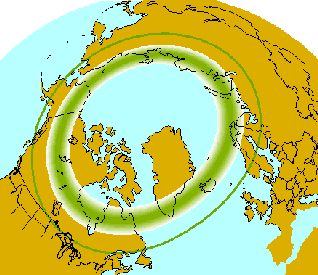
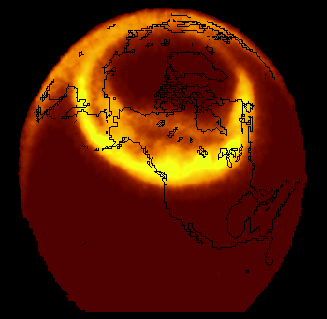
Viewedfrom the top, the aurora actually forms a luminous and electricallycharged cup (or chalice) shape extending into space from each pole.
We are all familiar with the sparks that flash brightly when wedischarge electrical current. Lightening is a good example. Extremelyhigh energy, called plasma, has been shown to form unique shapes whenit is made to discharge -- especially around a sphere. The northernlights are an example of how this "spark" of plasma can form luminous,electrically charged sheets or tubes at the Earth's poles. The aurora, as it is called, occurs when mild energy from our Sun is trapped and dissipated by the Earth's magnetic poles.
Extremely high energy -- the type that would have caused the Moon glassand zapped the Earth -- creates a more elaborate discharge. Physicistscall it a z-pinchformation. The z-pinch has been extensively researched by a groupheaded by Anthony L. Peratt with the Los Alamos National Laboratory,Los Alamos, NM and is described in his paper, Characteristics for the Occurrence of a High-Current Z-Pinch Aurora as Recorded in Antiquity Part II: Directionality and Source[5].In this paper, Dr. Peratt illustrates the shape and characteristics ofthis high energy discharge on the Earth and shows thousands ofpetroglyph sites all over the globe where this z-pinch was observed andrecorded in ancient carvings.
The term z-pinchoriginates from experiments where physicists made extremely highcurrent to flow through thin wires that were arranged vertically in atubular formation. They noticed that the energy quickly vaporized thewires, but the magnetic field generated by these paths remained andcontained (or "pinched") the stream of energy, collapsing the streamsof energy toward the center of the tube-like configuration -- calledthe z-axis. When the streams of energy converge, they form uniqueshapes that persist and can be observed as Birkeland elements, namedfor their discoverer.

[Above (left): Virtual image of the intense auroral plasma column as viewed at an angle of inclination, not to scale. Above (right): Conceptual view of the Birkeland sheath filaments surrounding Earth (28 close pairs). The relativistic electron flow is downwards toward Antarctica. The current bundle above Antarctica twists in counter-clockwise rotation. By convention, the Birkeland currents and ion flow is upwards toward the Arctic. Not yet completely resolved is a bend in the upper filament sheath that allows the upper plasmoids and column to be seen at northern latitudes.]
If the Earth was zapped by high energy radiation, either from the Sunor the Galactic core, the planet would be surrounded with distinctlines of energy, converging at the North and South pole. These bandswould continue to extend well out from the planet's poles and intospace and would be visible from almost every point on Earth -- eachwith its own unique perspective.
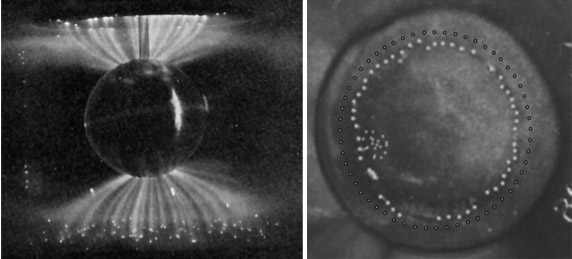
Laboratory experiments whith a metal sphere, representing Earth, show the "chalice" shape created by high energy paths [above].Oddly, repeated experiments show a preference for 56 "rays" or distinctbands of energy. This same number is often depicted in the ancientpetroglyphs!
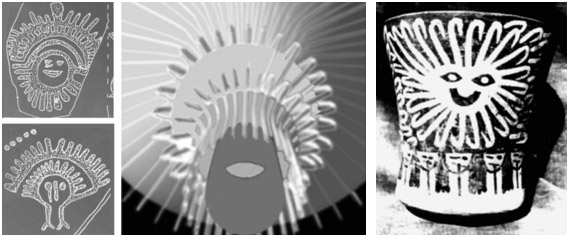
[Above (left): Northern hemisphere petroglyphs from the Columbia River Basin, 45.65ºN, 121.95ºW. Right: Oblique view into the auroral plasma column from these coordinates. Above (right): Nasca, Peru vase, date unknown (14.24ºS, 75.58ºW). Note the similarity to the northern hemisphere petroglyphs.]
Recentglobal archiving of global petroglyphs have demonstrated that theseshapes were correctly recorded in rock carvings by humans whowithnessed this event!
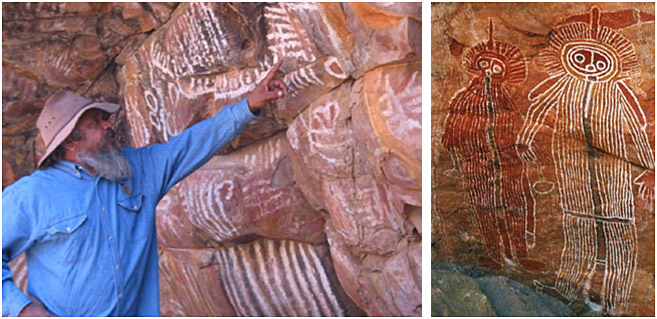
[Above (left):White-striped pictographs at Iga Warta Cultural Tourism Centre, NorthFlinders Range (30.59ºS, 138.94ºE). Shown is Cliff Coulthard,Australian Department of Environment and Planning in AboriginalHeritage, an authority on pictograph painting techniques havinganalyzed such works as the Magdalenian cave art in France. Above (right): LightningBrothers, Ingaladdi, Victoria River, Wardaman country of the NorthernTerritory (15ºS, 130ºE). New dating techniques of this redinorganic-pigmented pictograph image were done using a plasma-chemicalextraction method and correspond to the era of the z-pinch.]
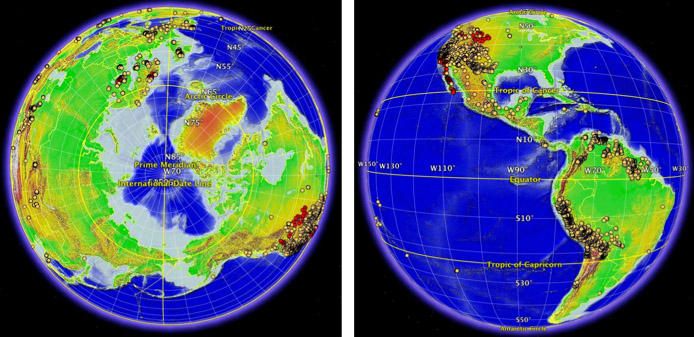
When researchers went to various petroglyph sites that contained thez-pinch artifacts they carefully plotted the GPS location and noted ifthe ancient artist had a clear view of the Southern horizon. Almost allof the sites had this view. The number and extent of these globalpetroglyph sites clearly demonstrate the purpose of this art. Also,depending on the latitude, depictions of the z-pinch corresponded tothe exact perspective that would have been expected.
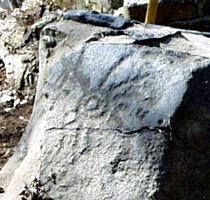
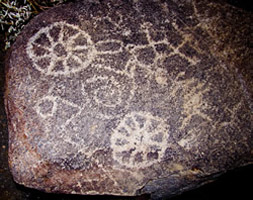
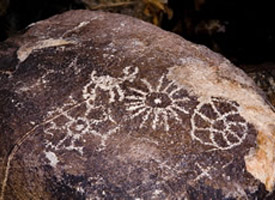
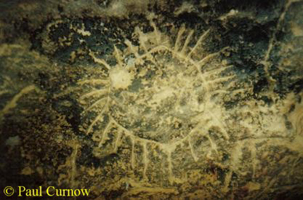
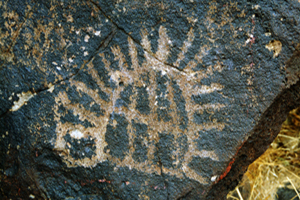
Some examples of z-pinch petroglyphs are shown here. Wehighly recommend reading the complete article. We especially thank teammember, John McGovern, for bringing this important work to ourattention.
So what do we know for sure?
The recent data shows that dramatic and potentially deadly effects canresult from solar flares and coronal mass ejections. Substantial datasuggests that an event, similar to the one anticipated in the 2012"doomsday" scenario, occurred about 14,950 years ago and was recordedby ancient humans. This event appears to have lasted for several yearsin duration and was responsible for the abrupt end of the last ice ageas well as a substantial culling of the human population.
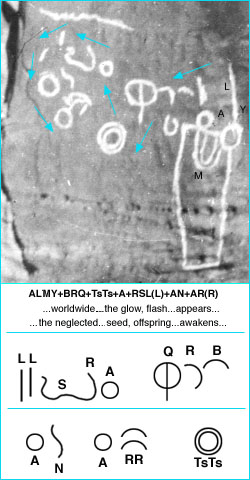 The surprising findings of LaViolette, supported by other research,suggests that the extreme solar event corresponded to powerfulradiation coming from the center of the Milky Way Galaxy and wasassociated with gamma rays and cosmic dust. Recent observations haveshown a dramatic increase in gamma ray energy in the Glaxy's equatorwhich will be in maximum alignment with our solar system on December12, 2012. The past records in ice cores (strata from 13,880 to 13,785BCE) suggest that intense radiation from this last event could havelasted many years. It seems highly likely that this alignment willcause another extreme solar event since other factors precipitating a"solar maximum" (i.e. the opposition of major planetary barycenters) also converge on this exact date.
The surprising findings of LaViolette, supported by other research,suggests that the extreme solar event corresponded to powerfulradiation coming from the center of the Milky Way Galaxy and wasassociated with gamma rays and cosmic dust. Recent observations haveshown a dramatic increase in gamma ray energy in the Glaxy's equatorwhich will be in maximum alignment with our solar system on December12, 2012. The past records in ice cores (strata from 13,880 to 13,785BCE) suggest that intense radiation from this last event could havelasted many years. It seems highly likely that this alignment willcause another extreme solar event since other factors precipitating a"solar maximum" (i.e. the opposition of major planetary barycenters) also converge on this exact date.
The fact that galactic centers routinely radiate lethal gamma raysmakes it unlikely that life, at least as we understand it, can survivein the universe. Sooner or later it is destined to be zapped.
A new genetic study of Y-chromosome variation by Dr. Marcus Feldman ofStanford University shows that the population from which the world'spresent population is derived consisted of about 2,000 individuals.Somehow, humans, flora and fauna did survive the past doomsday and somemay yet survive past 2012. Indeed, many of the ancient prophecies Ihave encountered in my travels around the world have spoken of a"bright light" or "flash" followed by the "good seed" (i.e. humanity)which would rise up and repopulate the world.[7]
Organisms on Earth, including humans, have evolved during quiet times-- between the lethal blasts from our own Milky Way center. This meansthat we are indeed quite unique (and lucky). But it also means that ourultimate demise is part of the natural order. This universe is largerthan ourselves and our lives. We are just transient phenomena,seemingly running counter to the laws of entropy, yet a part of thecosmic reality. This is neither good or bad. It simply is.
And yet there is part of us that may continue. This hope is what we must hold on to. Tell me what you think.
Comments? || Doomsday Part 1 || Viewzone MagazineReferences
[1] Gold, T. "Apollo II Observations of a Remarkable Glazing Phenomenon on the Lunar Surface." Science 165 (1969):1345.
[2] Excerpt from Paul LaViolette's 1983 Ph.D. dissertation, "Galactic Explosions, Cosmic Dust Invasions, and Climate Change."
[3] Morgan, Laul, Ganapathy, and Anders (1971 Morgan, J. W., Laul, J.C., Ganapathy, R., and Anders, E. "Glazed Lunar Rocks: Origin byImpact." Science 172(1971):556
[4] Zook, H. A., Hartung, J. B., and Storzer, D. "Solar Flare Activity: Evidence for Large Scale Changes in the Past." Icarus 32(1977):106
[5]Anthony L. Peratt, Fellow, IEEE, John McGovern, Alfred H. Qoyawayma,Life Member, IEEE, Marinus Anthony Van der Sluijs, and Mathias G.Peratt, Member, IEEE, "Characteristics for the Occurrence of aHigh-Current Z-Pinch Aurora as Recorded in Antiquity Part II:Directionality and Source," IEEE Transactions on Plasma Science, Vol.35, NO. 4, August 2007.
[6] Markus Landgraf, Max Plank Institute.
[7] www.viewzone.com/comanche2.html -also- www.viewzone.com/firsttongue.yemen.html -also- www.viewzone.com/oklahoma11.html
See also Mega Fauna Extinction (1.6mb pdf file)